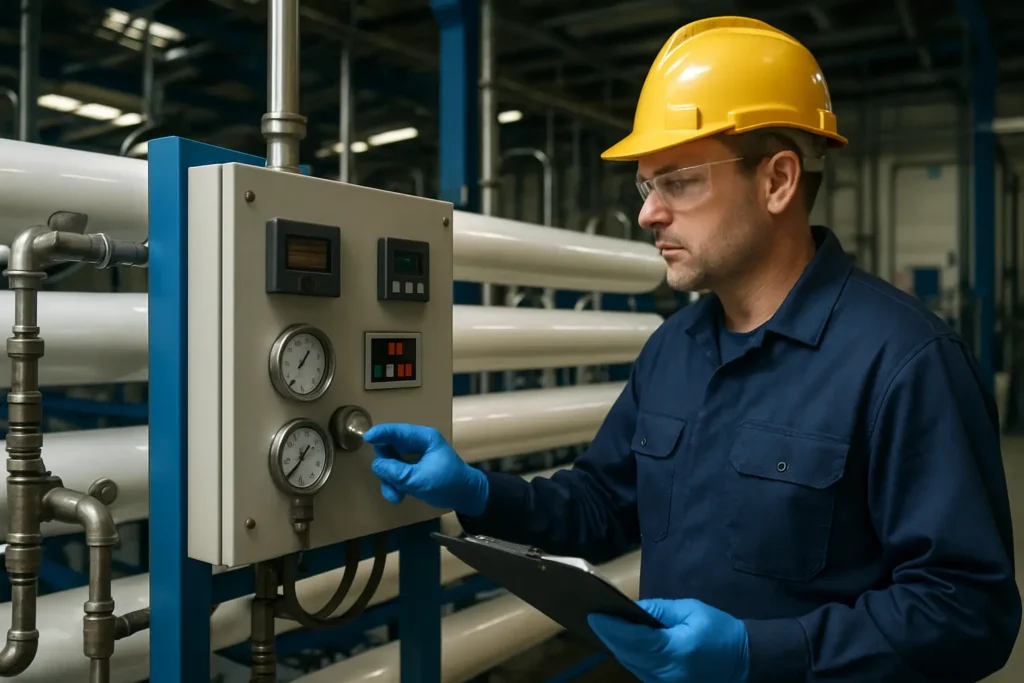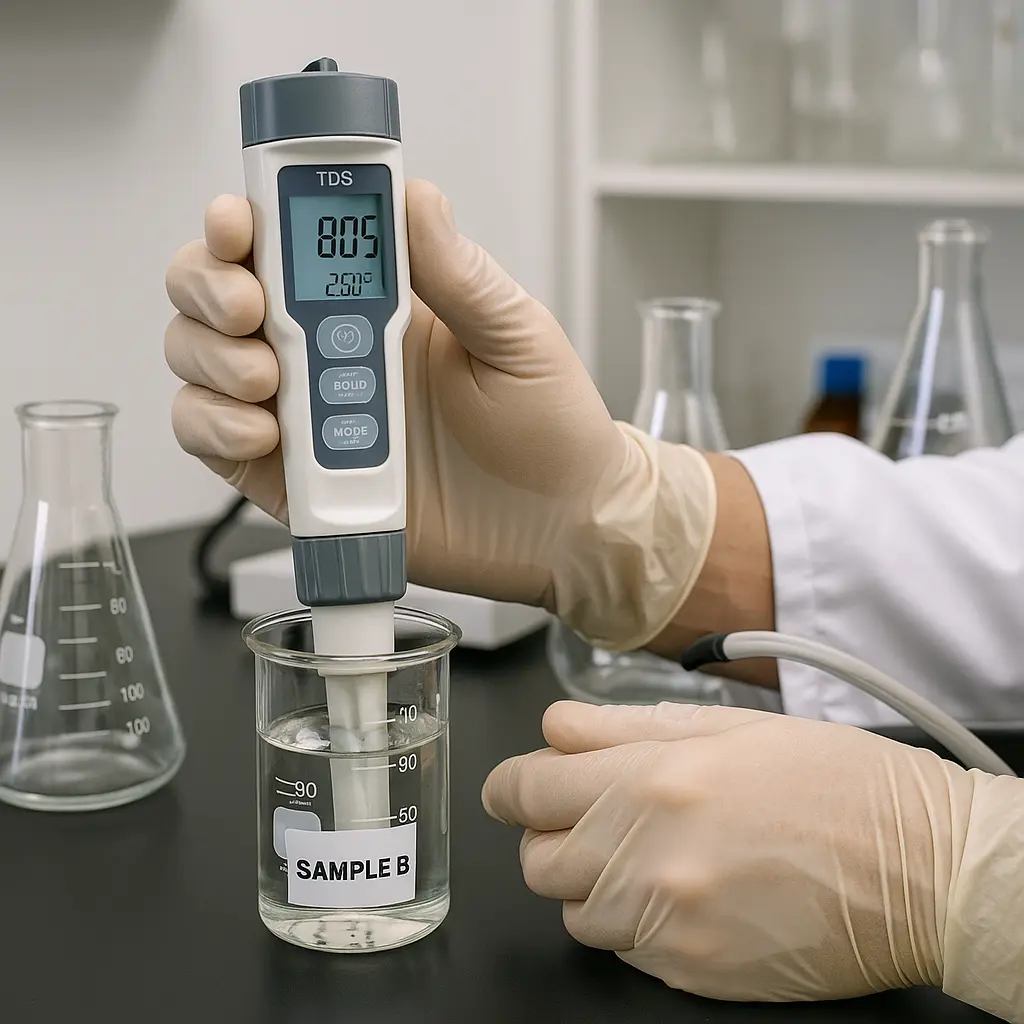ro membrane troubleshooting starts with data: normalized permeate flow, salt rejection, and differential pressure. This guide shows the fastest checks, a symptom-to-cause matrix, and exact tests and fixes for 1812/4040/8040 systems.
CIP and Cleaning Guide Replacement Checklist
Quick Checks
- Confirm valves and orientation: feed open, concentrate partially throttled, permeate to drain during start-up.
- Bypass tanks and post-filters during testing to remove backpressure effects.
- Replace clogged cartridges and verify dechlorination before TFC membranes.
- Record temperature, pressure at feed/concentrate/permeate, and TDS of feed and permeate.
ro membrane troubleshooting — key causes and thresholds
Effective ro membrane troubleshooting focuses on three signals: normalized permeate flow, salt rejection, and differential pressure. Clean when normalized flow drops about 10–15% or when ΔP exceeds supplier limits. Replace when rejection or flow cannot be restored to 90–95% of the clean baseline, or when oxidation damage or leakage is confirmed at end caps or interconnectors.
Always compare data at similar temperature and recovery. Many “low-flow” complaints are seasonal temperature effects; many “high-TDS” cases are actually backpressure from tanks or valves. Normalize first, then diagnose.

Symptom-to-Cause Troubleshooting Matrix
| Symptom | Likely Causes | Tests | Fix |
|---|---|---|---|
| Low permeate flow | Fouled membrane; clogged cartridges; low feed pressure; cold water; recovery too high | Normalized flow vs baseline; ΔP per stage; check pump curve and temp | CIP for the fouling type; replace cartridges; raise pressure within limits; reduce recovery |
| High permeate TDS / poor rejection | Oxidation damage; membrane end-cap leak; interconnector issue; extreme recovery | Salt rejection test; check chlorine upstream; pressure hold test; inspect seals | Replace damaged elements; fix leaks and orientation; correct recovery and backpressure |
| High differential pressure (ΔP) | Particulate/colloidal fouling; biofouling; iron/manganese scale | SDI/NTU; ATP/biological tests; Fe/Mn tests; visual sludge | Alkaline CIP for organics/bio; dispersant; reducing agent for iron; improve pretreatment |
| Frequent cleanings but no recovery | Wrong chemistry/temperature; irreversible damage; persistent upstream issue | Post-CIP rejection/flow vs baseline; inspect for oxidation; review antiscalant dosing | Switch chemistry and temp; repair root cause; schedule replacement |
| Noisy pump / cavitation | Starved suction; blocked strainers; air ingress | NPSH check; suction pressure; inspect for air leaks | Open valves; clean strainers; fix suction plumbing and priming |
Key Tests: Rejection and Normalized Flow
Acceptance criteria and baselines
- Set a clean baseline for each stage: normalized permeate flow, rejection, and ΔP at reference temperature.
- Use the same meters and units to avoid false trends; document every CIP and changeout.
- During ro membrane troubleshooting, test with permeate to drain so backpressure does not distort readings.
Salt Rejection (single-pass)
Rejection (%) = (1 − permeate TDS / feed TDS) × 100. Compare to your new-element baseline under similar temperature.
Normalized Permeate Flow
Correct flow to a reference temperature and pressure so day-to-day results are comparable. Most suppliers provide a correction factor table or equation. Track normalized flow per stage and compare with the clean baseline.
ro membrane troubleshooting — step-by-step rejection test
- Flush to stable operation; divert permeate to drain for several minutes.
- Measure feed and permeate TDS and temperature with calibrated meters.
- Compute rejection and record alongside pressure and flow.
- If rejection falls beyond acceptance criteria and does not improve after CIP, schedule replacement.
See the full cleaning procedure in RO membrane cleaning.
This checklist shortens ro membrane troubleshooting by confirming valves, removing backpressure, and normalizing data before deeper tests.
Log results after every ro membrane troubleshooting session so future drift is obvious and preventive actions can be scheduled.
Sensor and Setup Errors
- Miscalibrated TDS or conductivity meters cause false rejection alarms; calibrate regularly.
- Permeate backpressure from tanks or valves inflates TDS and reduces flow; test to drain.
- Mixed units or wrong temperature input during normalization leads to false trends.
Clean or Replace?
- Clean when normalized flow drops about 10–15 percent or ΔP exceeds limits.
- Replace when rejection or flow cannot be restored to 90–95 percent of baseline or oxidation/leakage is found.
Follow the RO membrane replacement checklist for safe changeout.
Preventive Maintenance
- Maintain SDI ≤ supplier limit and change cartridges on pressure drop, not just on calendar.
- Verify antiscalant dosage and pH; dechlorinate upstream of TFC membranes.
- Log normalized flow, rejection, and ΔP per stage; trend weekly to catch drift early.
For element format and vessel interfaces, see 4040 vs 8040 ro membrane et bwro vs swro membrane.
Common mistakes that waste time
- Comparing raw (unnormalized) flow from winter to summer and calling it a failure.
- Running TFC membranes with residual chlorine; rejection will never recover after oxidation.
- Testing through tanks and post-filters; permeate backpressure inflates TDS and reduces flow.
- Cleaning with the wrong chemistry or too cold; organics/bio need warm alkaline with surfactant before acid.
References
DuPont FilmTec RO/NF Technical Manual | AMTA Fact Sheet – Cleaning in Place (CIP)
FAQs
What is an acceptable salt rejection for a new element?My flow is fine but TDS is high. What should I check?ΔP climbs within days after cleaning. Why?
For a complete changeout workflow after ro membrane troubleshooting, see our RO membrane replacement guide.
Need Help with a Live Issue?
Send feed TDS/temperature, stage pressures, normalized flow, and recent CIP history. Our engineer will suggest tests and a corrective plan.

